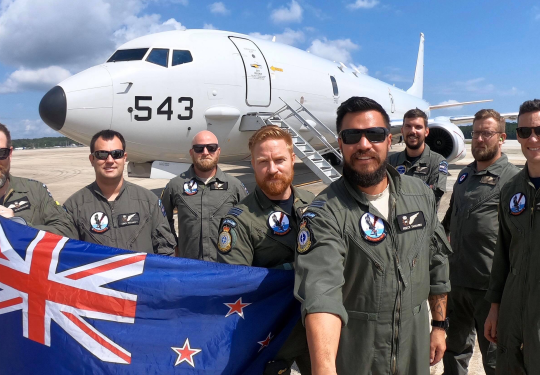Kiwis help in Bahamas search and rescue
The New Zealand crew training with the P-8A Poseidon maritime patrol aircraft in Jacksonville, Florida, was recently involved in a dramatic rescue of a group of Haitians, including a baby, after their vessel capsized off the coast of Grand Bahama.
26 July, 2021
The Royal New Zealand Air Force No. 5 Squadron crew were on board two US Navy P-8As on a maritime intelligence, surveillance, reconnaissance exercise with US Navy instructors when a radio channel lit up with a distress call from the United States Coast Guard, RNZAF Flight Lieutenant Reece Tamariki said.
In the United States, the US Navy does not generally get involved in search and rescue tasks, a role which is carried out by local police and Coast Guard.
However, No 5 Squadron’s role includes year-round, fast notice search and rescue tasks, so the Kiwis were able to offer some of their own experience and insight into search options.
A 24ft vessel had capsized, and while eight survivors and two deceased had been recovered, there were up to six more people still in the water in need of rescue.
The P-8As were 80 nautical miles north of the search area, which was just six nautical miles off Grand Bahama.
Both aircraft responded and flew south in preparation for an official request for assistance.
“The Royal Bahamian Police and US Coast Guard were already on scene, and the regional Rescue Coordination Centre was made aware of the P-8As’ positions and ability to assist. A search area was developed and the two aircraft were then requested to aid in the search,” Flight Lieutenant Tamariki said.
The capsized vessel was found initially on radar and then visually. Once the drift was assessed, both aircraft commenced a visual search for survivors in the water, unaware exactly how many people were involved, or what survival aids they might have had.
That area of ocean was dead flat, and the visibility was excellent, so the crew held a quiet confidence that if they flew overhead, they could spot survivors in the water, Flight Lieutenant Tamariki said.
“The search and rescue was unlike most missions Air Force operators are used to, with a helicopter, three fixed-wing aircraft, a Coast Guard vessel and Bahamian Police boats all on scene to assist.”
On board one of the aircraft, RNZAF Flight Sergeant Nick Rowe briefed the observers in the windows on their duties upon seeing anything in the water, and then controlled the sensors. Flight Lieutenant Tamariki coordinated the aircraft’s search while the US Navy instructors focussed on communication and deconfliction with the other aircraft.
"Upon completion of the tasked search area, and 45 minutes away from minimum gas, the aircraft were requested to return to base, refuel and head back to the search area,” Flight Lieutenant Tamariki said.
The search was eventually called off with a number of people still missing.
“The crew were sobered as a Haitian woman and a boy had died, while the survivors were taken to back to land for treatment. The event was a bleak reminder of the importance of the job No. 5 Squadron currently do with P-3K2 Orions, and will continue to do with the P-8A Poseidons.”
Eight No. 5 Squadron personnel and their families deployed to Jacksonville early last year to begin a three-year deployment working with P-8A Poseidon aircraft, training to be the first RNZAF instructors when the P-8As arrive in New Zealand in 2023.
